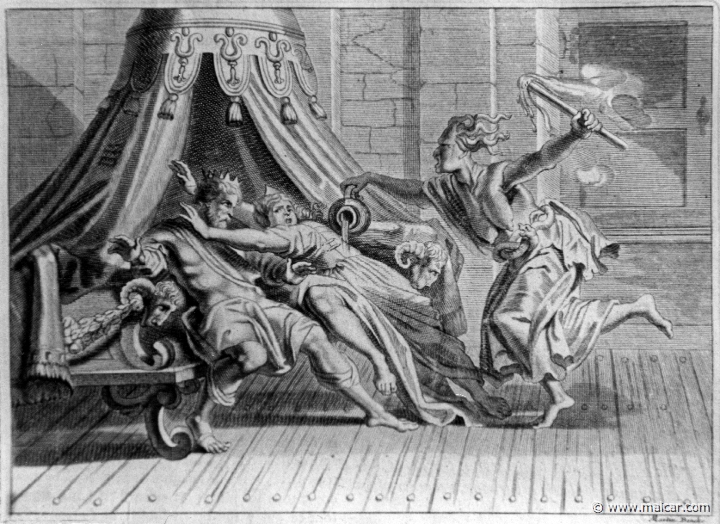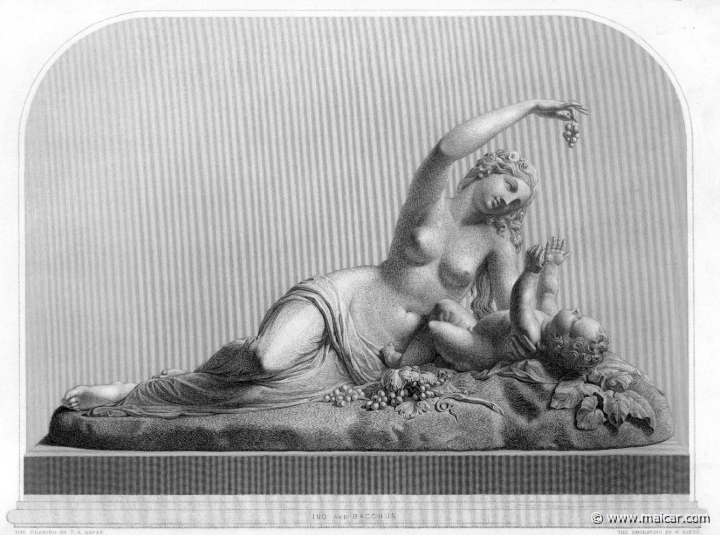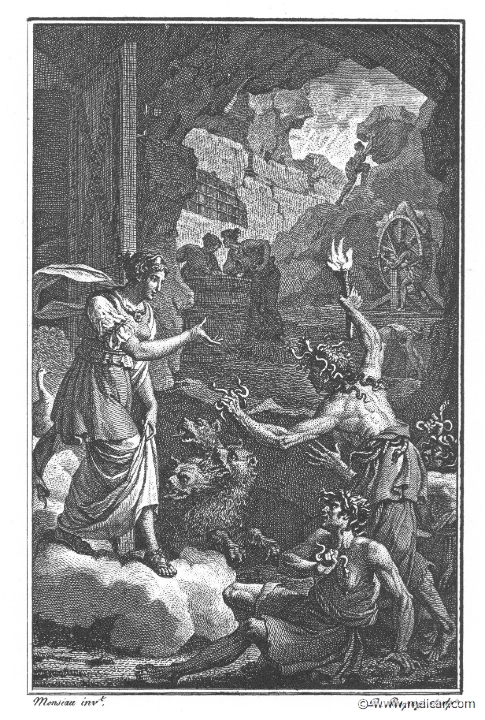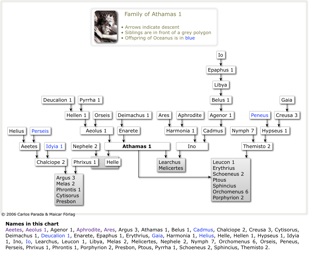 |
|
|

|
2634: Tisiphone maddens Athamas and Ino. Les METAMORPHOSES D’OVIDE EN LATIN ET FRANÇOIS, DIVISÉES EN XV LIVRES. TRADUCTION DE Mr. PIERRE DU-RYER PARISIEN, DE L’ACADEMIE FRANÇOISE. MDCLXXVII.
|
|
Athamas 1 was king first in Boeotia and then in Thessaly. As his second wife Ino plotted against the children of his first wife Nephele 2, he almost sacrificed his son Phrixus 1. Hermes entrusted Dionysus 2 to Athamas 1 and Ino, and persuaded them to rear him as a girl. But Hera (or Tisiphone 1) drove them mad, and Athamas 1 hunted his elder son Learchus as a deer, killing him. Athamas 1 was then banished, and settled in the country he named Athamantia marrying Themisto 2 and having other children by her.
Ino's plot
Athamas 1 married first Nephele 2 and had children, Phrixus 1 and Helle by her. But when Athamas 1 married his second wife Ino, she plotted against the children of his first wife. This is what Ino did: she persuaded the women of the country to parch the wheat without the knowledge of the men, and as a result the earth did not yield its annual crops. When the country was then suffering from dearth, Athamas 1 sent messengers to the oracle of Delphi to inquire how they might be delivered from the calamity. But Ino persuaded the messengers, in one way or another, to falsify the oracle and say that it had been foretold that the dearth would cease if Phrixus 1 were sacrificed. When this was known, the people, easily deluded by the promises of the false oracle, demanded from Athamas 1 compliance with it, forcing him to bring his own son to the sacrificial altar. However, before he was able to satisfy the public demands, his wife Nephele 2 put her son Phrixus 1 along with her daughter Helle on the back of the Ram with the Golden Fleece, which she had received from Hermes, and flying on it they escaped.
Fate of Phrixus 1 and Helle
Helle slipped into the sea, which was called Hellespont after her, and was drowned; her tomb was said to be in the Chersonesus, which is the Thracian peninsula separated from Asia Minor by the Dardanelles. But Phrixus 1 came to Colchis (Georgia in the Caucasus), and having sacrificed the Ram, he gave the Golden Fleece to King Aeetes and married his daughter Chalciope 2, who some have called Iophossa. (More about Phrixus 1 under Family below). Others have said that it was Demodice who plotted against Phrixus 1. For she, though being married to Cretheus 1, brother of Athamas 1, fell in love with Phrixus 1 and when he did not return her love, she accused him to Cretheus 1, saying that he had attacked her. Having heard this report, Cretheus 1 persuaded his brother Athamas 1 to put Phrixus 1 to death, and it was then, they say, that Nephele 2 intervened to save her son, sending him away on the back of the Ram with the Golden Fleece along with his sister Helle.
|

|
Ino nursing the child Dionysus 2. print004: Ino and Bacchus. Engraving (c. 1860) from a sculptural group by John Henry Foley 1818-74.
|
|
Athamas 1 and Ino protect the child Dionysus 2
These are the times when the god of the vine
Dionysus 2 was born
out of Zeus' thigh. For
Dionysus 2's mother
Semele, deluded by
Hera, asked
Zeus to appear before her
as he usually appeared before
Hera and he, having
promised to grant whatever she asked, could not
refuse. So the god came in the midst of
thunderings, lightnings and thunderbolts, and
Semele died of fright.
Zeus then snatched from the
fire the six-months abortive child and sewed it
inside his thigh, but when later he undid the
stitches and gave birth to
Dionysus 2, he
entrusted him to Hermes, who in turn gave the child to Athamas 1 and Ino, persuading them to rear him as a girl. This is why Hera, who
already had succeeded in destroying
Semele, decided to destroy both Athamas 1 and Semele's sister Ino
(these two girls are daughters of
Cadmus), who now were
protecting and rearing the son of her husband's
mistress.
For this purpose, Hera
descended to the
Underworld and asked
the ERINYES, with commands, promises and prayers, to drive Athamas 1 mad. So one of them, Tisiphone 1, who usually guards the entrance to Tartarus, seizing a torch steeped in gore, putting on her bloodstained robe, and girding round her waist a snake, came out from the Underworld followed,
as they say, by Grief, Terror, Dread and
Madness.
Dreadful vision
Tisiphone 1 was not the sight King Athamas 1 and his wife were longing to see, and when they tried to escape, the vision stood in their way, stretching her arms wreathed with serpents. Some of these, they say, lay on her shoulders and others twined round her breasts, hissing and vomiting poisonous gore and darting out their tongues. Tisiphone 1 then teared away two serpents and these, having been hurled at Athamas 1 and Ino, breathed their pestilential breath upon them. Next Tisiphone 1 poured over their breasts a maddening poison brew composed of froth of Cerberus 1, poison of the Hydra, Hallucinations, Oblivion, Crime and Tears, Love of Slaughter, and blood and hemlock, making it sink to the core of their being. For, as it is said, the king and queen did not suffer any physical injury, the deadly stroke being aimed at their minds.
Athamas 1 kills Learchus
|

|
Hera meets the ERINYES in the Underworld. Beside her is Cerberus 1; at a distance the DANAIDS fill the leaky jar, Ixion whirls in the wheel, and Sisyphus pushes the stone. 01137: Hera and Tisiphone. "When Juno had spoken, Tisiphone, just as she was, shook her tangled grey locks, tossed back the straggling snakes from her face..." (Ov. Met. 4.473). Guillaume T. de Villenave, Les Métamorphoses d'Ovide (Paris, Didot 1806–07). Engravings after originals by Jean-Jacques François Le Barbier (1739–1826), Nicolas André Monsiau (1754–1837), and Jean-Michel Moreau (1741–1814).
|
|
Her task accomplished, Tisiphone 1 left. Straightaway Athamas 1 started to hallucinate, believing her wife was a lioness. And snatching his little son Learchus from his mother's arms, he whirled him round and dashed his head against a rock. But others affirm that Learchus died shot by an arrow, being hunted by his father as if he were a deer.
Death of Ino and Melicertes
Ino, stung to madness too, took their other child Melicertes, and fled away howling. Having climbed to a cliff, and still bereft of sense, she then leaped with her child far above the sea. Others say that Ino threw her child Melicertes into a boiling cauldron and that, carrying it with the dead child, she sprang into the sea. Still others assert that it was Athamas 1 who laid Melicertes in the cauldron. However, Ino was no ordinary girl, but the granddaughter of Aphrodite. And the goddess, having witnessed the end of Ino and her child Melicertes, asked Poseidon to receive them as sea-deities and he, consenting to her prayer, took away from Ino and her son their mortal parts. From that day Ino and Melicertes are known as Leucothea and Palaemon 3, a goddess and a god who live in the sea, giving help to sailors during storms. Some have said that Melicertes was landed on the Isthmus of Corinth by a dolphin. He was then renamed Palaemon 3, and the Isthmian games were celebrated in his honour.
Saving Dionysus 2
In any case, Dionysus 2 had to elude Hera's wrath; and so, when these events took place, Zeus turned his child Dionysus 2 into a kid, and Hermes took him to Nysa in Asia, giving him to the nymphs called HYADES 1, who dwell there and are said to be the daughters of Atlas.
Athamas 1 emigrates
In the meantime, Athamas 1, having suffered two plots, was banished from Boeotia and lost all his children. Not knowing where to live, he inquired the oracle, receiving the answer that he should dwell in whatever place he should be entertained by wild beasts. So when Athamas 1, being in Thessaly, fell in with wolves that were devouring sheep and saw them abandon their prey and flee, he thought that this was the oracle's fulfilment. He then stayed in that country, and called it Athamantia after himself. There Athamas 1 married his third wife Themisto 2 (daughter of King Hypseus 1 of the LAPITHS, son of the river god Peneus), and had children by her. (For more details about Themisto 2 and her children, see Family below). The death of Athamas 1 has not been reported.
Namesakes
- Athamas 2 is a son of Oenopion 1, son of Ariadne, the daughter of Minos 2, either by Theseus or by Dionysus 2.
- Athamas 3 is one of the sons of Aegyptus 1; he married Pyrante, one of the DANAIDS, and was killed by her.
- Athamas 4 is a descendant of Athamas 1 and the founder of Teos in Ionia.
|
| Family |
|
|
|
|
|
|
Aeolus 1 & Enarete
|

Nephele 2
|

Phrixus 1

Helle
|
To avoid being sacrificed, Phrixus 1 fled and was borne through the sky to Colchis by the Ram with the Golden Fleece. On reaching the shore, the Ram was turned into a constellation, but his golden fleece was carried to Colchis. Phrixus married King Aeetes' daughter Chalciope 2, and had children by her. However, Aeetes, fearing for his
own life and kingdom on account of prodigies that
had warned him against a foreigner descendant of
Aeolus 1, killed Phrixus 1. But others have said that Phrixus 1 died after a long life, and that suddenly there appeared a flame in heaven, and the ram in a constellation. (For Phrixus and Helle see also main text above.)
|

Ino
|
|
Some have said that Ino's plot against Phrixus 1 (see main text above) was revealed by the messengers or messenger who had lied about the oracle, saying that it demanded the sacrifice of Phrixus 1. When Athamas 1 was thus informed of Ino's plot, he decided to execute her and her son Melicertes. It is said that Dionysus 2 then protected them, casting mist around his nurse Ino. When later Athamas 1 went mad, and Ino threw herself into the sea with her child Melicertes, Dionysus 2 called them Leucothea and Palaemon 3.
|
|
|
Leucon 1
Erythrius
Schoeneus 2
Ptous
Sphincius
Orchomenus 6
Porphyrion 2
|
Themisto 2 is daughter of Hypseus 1 by a Nymph. Some have said that Themisto 2 had two sons, Sphincius and Orchomenus 6, and that she plotted against the children of Ino. Themisto 2, they say, hid in the palace and, deceived by a nurse who had put the wrong garments on the children, killed her own sons instead of killing Ino's. When Themisto discovered what she had done, she killed herself.
Leucon 1 died of a sickness. He had a daughter Evippe 3, who married Andreus 1 (after whom Andreis in Boeotia is called), son of the river god Peneus. Eteocles 2, son of Andreus 1 and Evippe 3, was king in Boeotia and died childless. Leucon 1 had also a son Erythras 2 after whom Erythrae in Boeotia was named. He was one of the SUITORS OF HIPPODAMIA 3, being killed by King Oenomaus 1.
Ptous is said to be the twin brother of Porphyrion 2. It is told that these were the children that Themisto 2 killed, believing they were Ino's sons. Mont Ptous in Boeotia is called after Ptous.
|
|
|
|
|
|

|
Genealogical Charts
Names in this chart: Aeetes,
Aeolus 1, Agenor 1, Aphrodite,
Ares, Argus 3, Athamas 1, Belus 1, Cadmus, Chalciope 2, Creusa 3, Cytisorus, Deimachus 1, Deucalion 1, Enarete, Epaphus 1, Erythrius, Gaia, Harmonia 1, Helius, Helle, Hellen 1, Hypseus 1, Idyia 1, Ino, Io, Learchus, Leucon 1, Libya, Melas 2, Melicertes, Nephele 2, Nymph 7, Orchomenus 6, Orseis, Peneus, Perseis, Phrixus 1, Phrontis 1, Porphyrion 2, Presbon, Ptous, Pyrrha 1, Schoeneus 2, Sphincius, Themisto 2.
|
|
|
| Related sections |
ARGONAUTS, Underworld, Madness |
|
|
Sources
Abbreviations |
Hyg.Fab.1, 4, 239; Apd.1.7.3, 1.9.1-2,
3.4.3; Ov.Met.4.480ff.; Hes.CWE.4; Hdt.7.197; Nonn.5.198,
5.557, 9.56, 9.304, 9.317; Pau.6.21.11, 9.34.7-8.
|
|
|